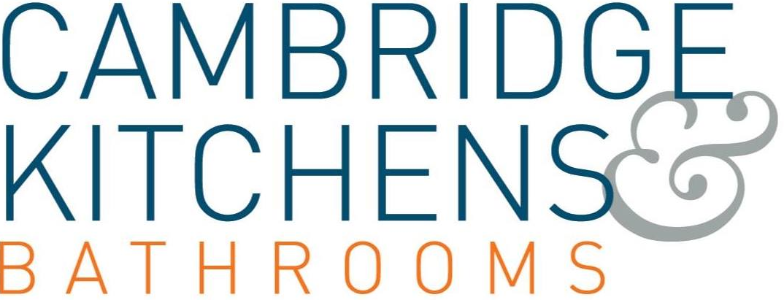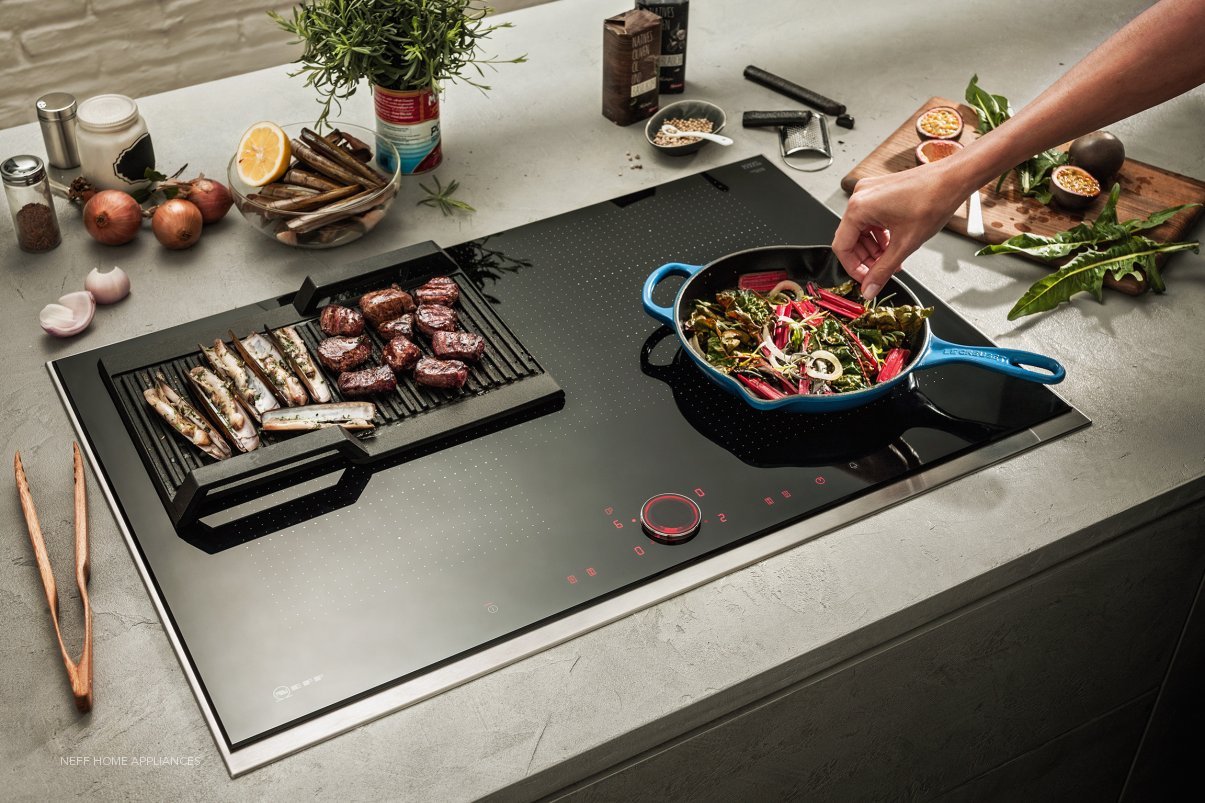Kitchen hobs, your kitchen is not complete without one, but there are so many to choose from. With the introduction of induction hobs and domino hobs, there has never been so much choice and also confusion. However, the good thing about an increased range of hobs is that you can find one which will suit you perfectly. This guide aims to help you understand the different types of hobs and what each is best at, plus we’ll look at some modern hob features.
Types of Hob
Gone are the days where you simply choose from gas or electric, now you’re able to choose from; gas, electric, induction and domino hobs. To make life a little bit simpler for you, we’ve gone through each to explain the differences between them.
Gas Hobs
Gas hobs are very easy to control and they give instant heat, they have the advantage of distributing the heat well across the bottom of the pan meaning you can focus on what you’re cooking. Here is a quick breakdown of what’s good and not so good about gas hobs:
- You can lift or tilt the pan and you’ll still be getting heat, giving you a lot of versatility to your cooking. These hobs are very popular with professional chefs because they need the very fine control and instant heat.
- They can be used with any type of pan meaning that you don’t need to replace your pan set.
- Some gas hobs can be slightly noisy.
- The cooking area on a gas hob cools down very quickly after cooking because the majority of the heat is going directly into the pan.
- They are considered to be more efficient than electric hobs. However, in recent year’s induction hobs have overtaken gas and are now considered the most efficient.
- The design is a personal choice, some prefer the more industrialised look of a gas hob, and some think they look ‘old fashioned’.
- They are certainly harder to clean because of the pan support frame, particularly when compared to the simple flat surface of a ceramic hob or induction hob.
- They are considered more dangerous because of the risk of a gas leak.
- They are more likely to require maintenance because of all the parts.
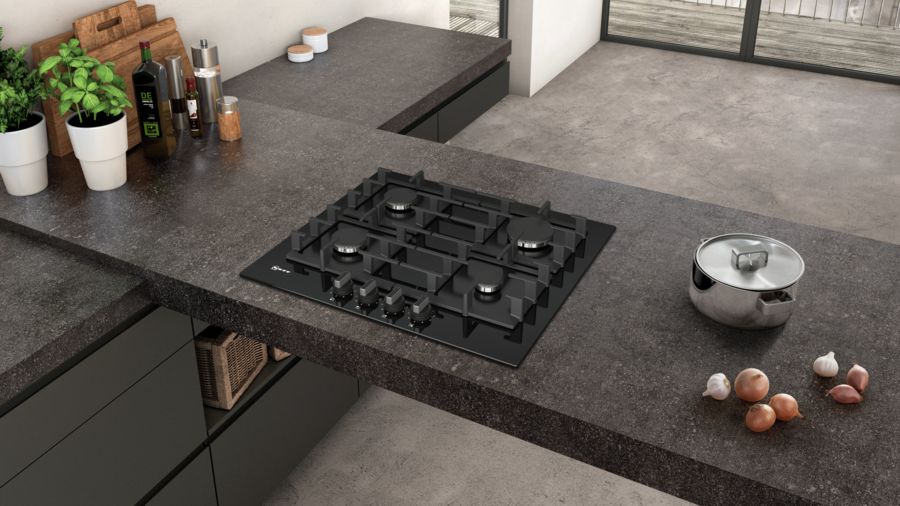
These hobs are incredibly simple and haven’t changed much over the years, some have large gas rings or special rings for woks, but they remain basically the same as when they were first invented. Gas hobs are still popular with a lot of people though, they hold a nostalgic value with a lot of people because for years they were considered the best type of hob, but with induction hobs getting better and better, their days are numbered.
Ceramic (Electric) Hobs
Electric hobs tend to be the ceramic type, you rarely get the electric plate hobs, except perhaps on the cheaper brands, the majority of the industry has gone to the ceramic hobs. This is because they are a simpler and more efficient type of electric hob, plus they have a better design and are easier to clean. Here are a few of the benefits and drawbacks of ceramic hobs:
- They can be simply wiped clean, because of their completely flat design. However, when the ring is hot, food burns onto them easily.
- They take a relatively long time to heat up and cool down, meaning they use more energy compared with gas and induction hobs. Some models feature a power boost which can reach the maximum temperature up to 50% quicker.
- When you remove the pan from the ring a lot of heat is lost, particularly compared to gas.
- Similar to gas, any type of cooking pots can be used on a ceramic hob.
- Most ceramic hobs are not able to cope with wok cooking, but there have been a few models in recent years which can.
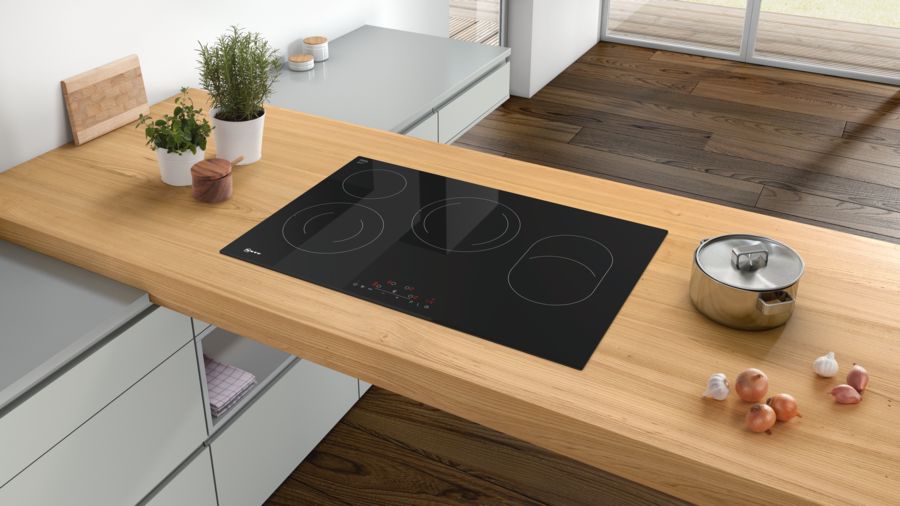
A lot of manufacturers are slowly killing off their range of electric hobs, both traditional plate and ceramic, in favour of the induction hobs because they simply cannot compete. There are so few benefits over either gas or induction that most kitchen retailers would advise you not to consider a ceramic hob.
Induction Hobs
Induction hobs are more complicated than gas or electric, but offer a much better cooking experience. They work by creating a magnetic field between the hob and the induction element and the pan, this causes the pan to heat up. Here are some of the advantages and disadvantages of induction cooking:
- It is the pan that heats up, not the surface of the hob, meaning induction cooking is more efficient than gas and electric.
- They are considered to be the safest type of hob. Because it is the pan that is heated, and not the hob, the hob cools down much quicker. Plus, there is no gas and therefore no risk of gas leak.
- You can use any sized ring for any sized pan.
- You will however potentially need new pots and pans, but it’s definitely worth checking your current set because most are induction hob compatible.
- Induction hobs are easy to clean, because very little food gets burnt onto the hob and most can be wiped away with a damp cloth.
- There is a risk to those fitted with a pace-maker because of the magnetic field generated (we advise you speak directly to the manufacturer about this).
- Some of the newer induction hobs are now zoneless, meaning that you can place the pan anywhere within a set zone.
- A lot of induction hobs feature a power boost for quick heating.
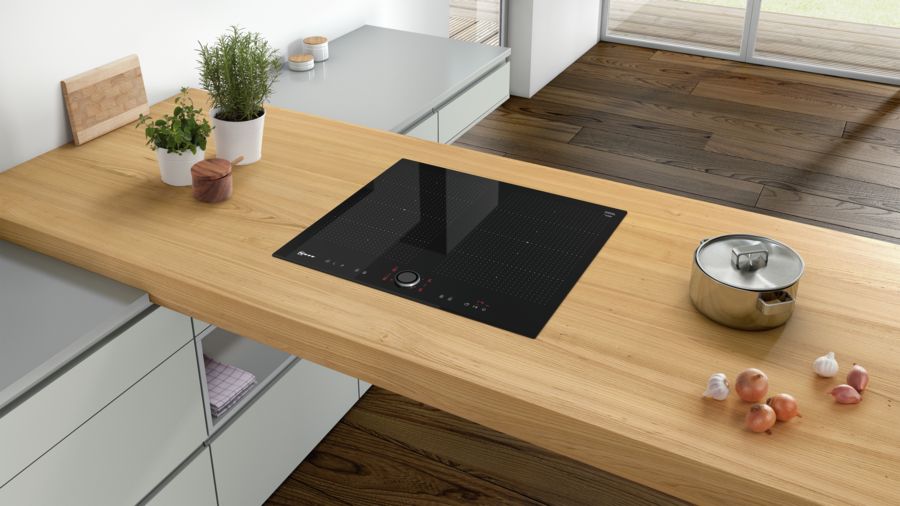
Induction hobs have taken a while to become established within the market, but as the technology has improved, so too has the quality of the hobs. These hobs are now where a lot of manufacturers are investing their research budget, so we’ll see the technology in them improve even further over the coming years. You can find out more about induction hobs in our guide (LINK).
Domino Hobs
Domino hobs are for the real cooking enthusiasts, they’re for those people that want to create the ultimate cooking experience. They’re oblong shaped hobs which can be placed next to a larger hob, or used with other domino hobs, to add an extra cooking capability. For example, you may have brought a large induction hob, but you still need to have the capability to cook with gas, a domino hob containing 1 large gas burner would be perfect for this. There are a variety of domino hobs to suit your cooking: electric, induction (flat), Wok induction (with bevelled wok placement), deep fat fryer, BBQ grill (electrically heated), gas and Tappenyaki hobs. Domino hobs have a few advantages and disadvantages that are worth considering:
- They take up extra worktop space.
- Can be expensive for their size.
- They’re great for counteracting the drawbacks of induction or gas hobs.
- Enable you to create the ultimate cooking experience tailored to your cooking needs.
- You wouldn’t get all of the features you may on a larger hob.
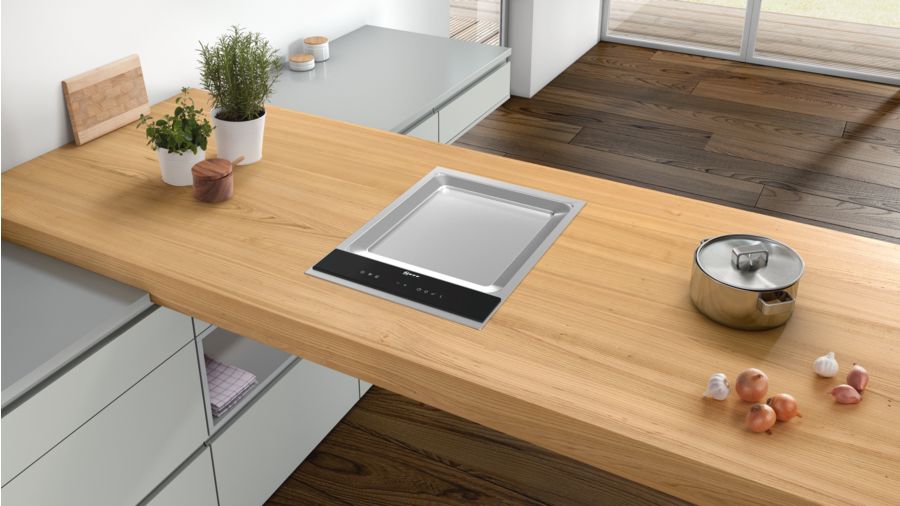
Domino hobs are not for everyone, most people would be happy with just their standard hob, but for those that want to go that extra mile they’re perfect. As technology improves we’ll start to see more domino hobs appear on the market with better features, perhaps one day it’ll be normal to have several domino hobs lined up rather than just one large hob.
Think about extraction
If you’re after that perfect cooking experience then you need to be thinking about your extraction at the same time as your hob choice. Traditionally extractor fans have only been situated above the hob, but with technological improvements from NEFF there are now venting hobs and rise & fall extractors. If you’d like more information on choosing an extractor fan/cooker hood for your kitchen, take a look at our detailed guide (LINK). Below are the different options available to you:
Island extractor fans
These are mounted above your hob and are perfect for when you have your hob located in the middle of the kitchen. They look great, particularly in traditional kitchens, but if you go for an extraction hood (sending the air outside), then you’ll need ducting in your ceiling. You also need to consider head room to ensure you can lean over your hob easily.
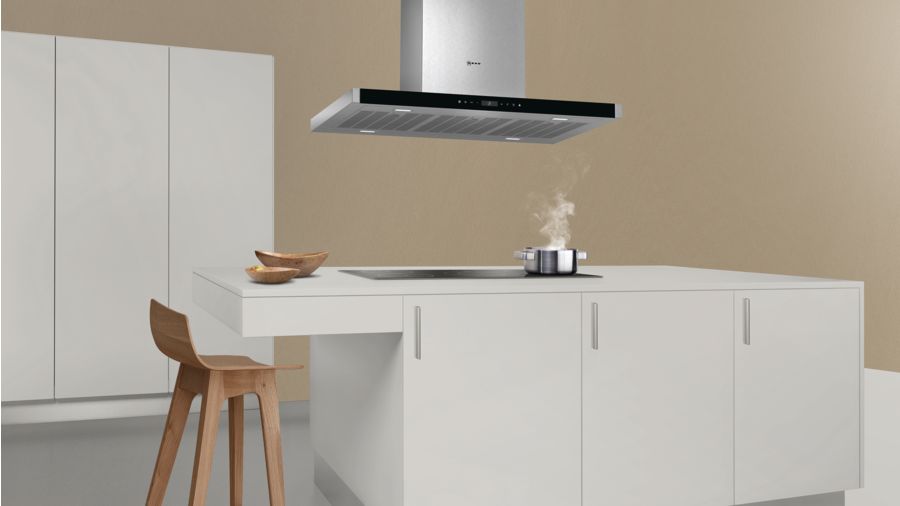
Wall mounted extractor fans
When you have your hob next to a wall perhaps a wall mounted extractor may be more suitable. These are no longer simple metal boxes, they can actually be very attractive and well-designed appliances which complement the overall design of your kitchen.
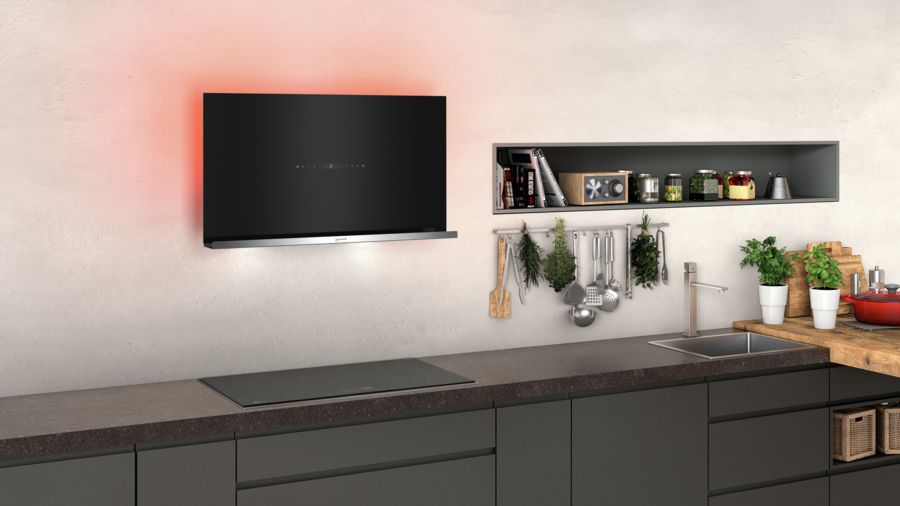
Downdraft extractors
These are still a relatively recent innovation; they provide a perfect solution for those with an island hob, but not wanting the overhead extraction. These extractor fans rise up out of the worktop with the press of a button and suck the air from above the cooking area, pulling it down under the worktop to be extracted or filtered. When you’re finished with them, simply press the button and they sink down into the worktop again.
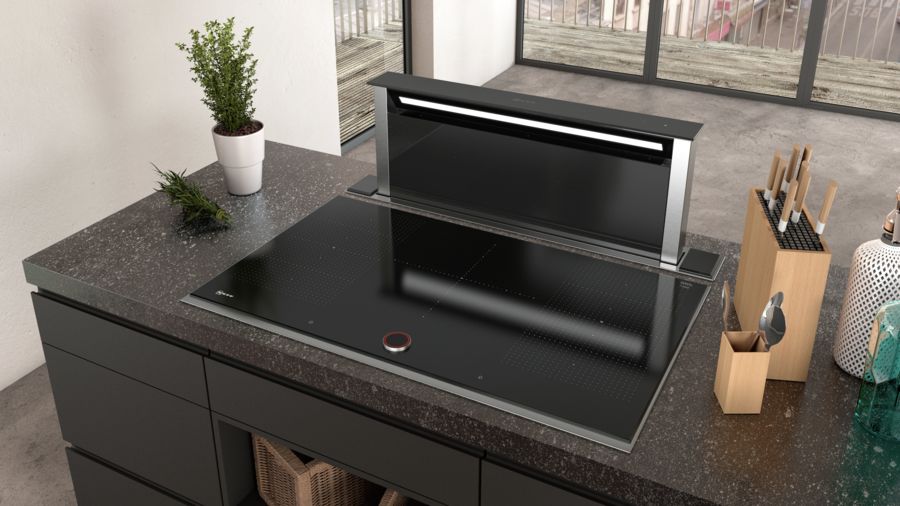
There are a few manufacturers that make them, with Siemens and NEFF being the most renowned. Here is a video showcasing the Siemens rise and fall extractor:
Induction hobs with integrated extraction
The most recent innovation in the world of extractor fans is the Flex induction venting hob, these hobs integrate a state of the art induction hob with an extractor fan in the middle. These are great for kitchens which do not have a large amount of space on the counter or for those that do not want the extractor fan visible, even when cooking. Also, these extractor fans do not take up as much room as you think they would in the cupboard below because of some cleaver technology in the routing of the ducting.
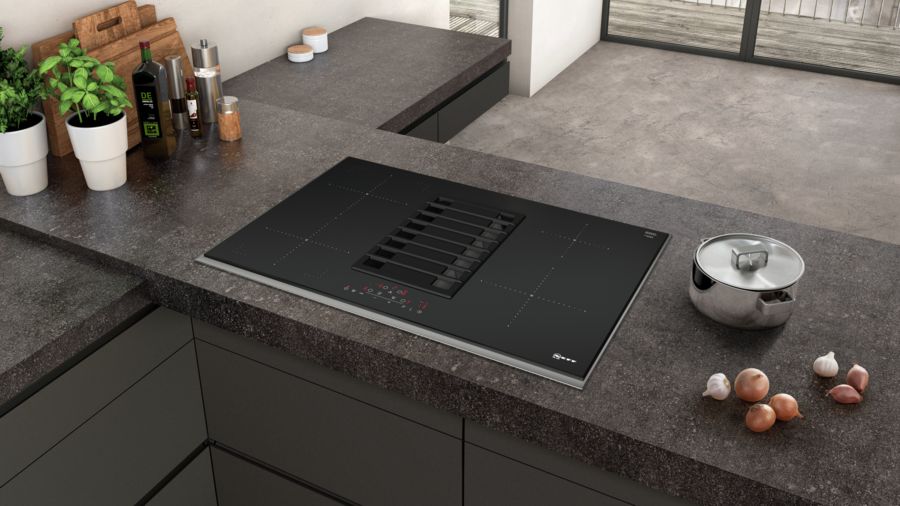
Controls
When you’re cooking with several pans on your hob at once it can get a bit chaotic, you need to be able to quickly and reliably control the heat with precision. There are a variety of control options out there, here are the just a few which NEFF and Siemens use:
- Touch Control – Touch sensitive controls which can be easily wiped clean. They even work well with wet hands or when there is moisture on the surface.
- TwistPad – A magnetic control knob giving you very precise control of your settings of each cooking zone. The TwistPad is removable (because it is only held on with magents) to enable easy cleaning.
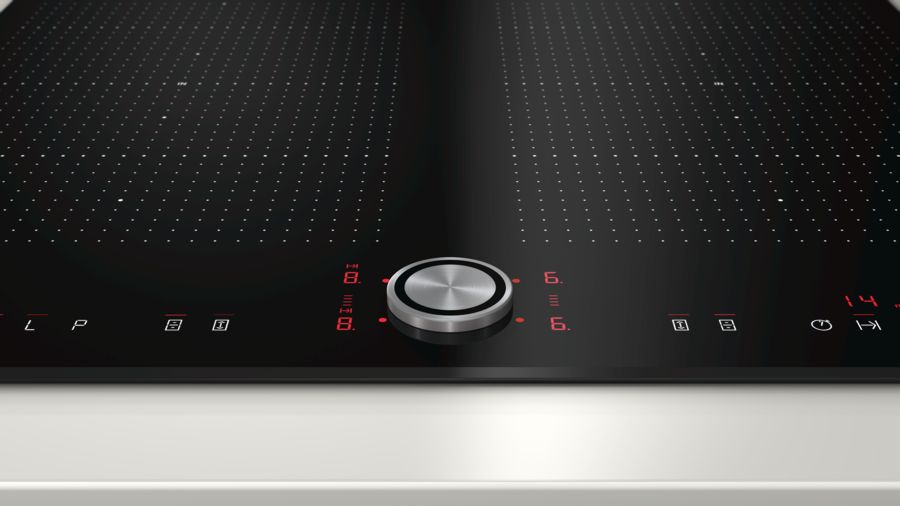
- Gas control knobs with digital readout – These provide a digital display showing the power levels for a particular cooking zone on your gas hob. They also show which cooking zones have residual heat after cooking.
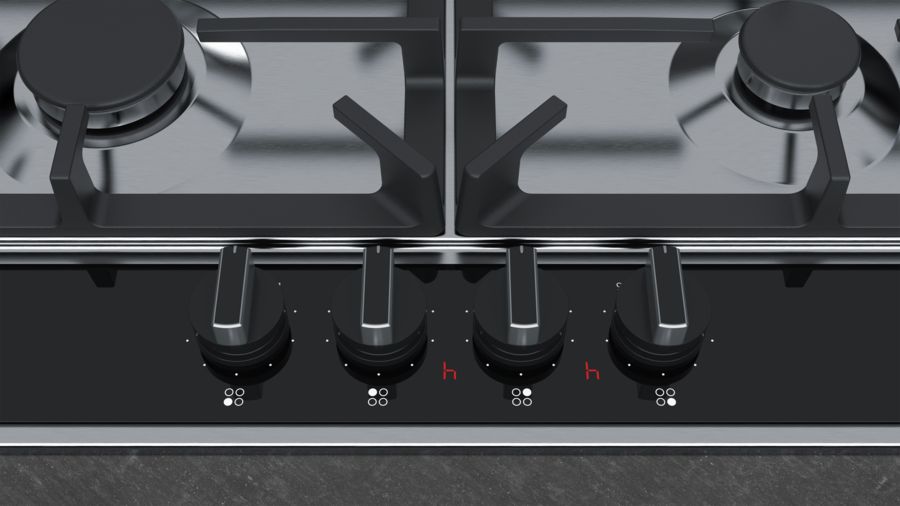
Flex-Induction
There are induction hobs, then there are flex induction hobs, these hobs represent the next big leap in hob cooking. Previously you could only cook on designated rings and if you had a pan larger than that ring, not all of it would be heated. Flex induction cooking removes the individual rings and creates zones, much larger than before and able to handle everything from large pans to small saucepans. The hob detects where the pan is and just applies the energy to that one area, and you can cook with several pans on the one area.
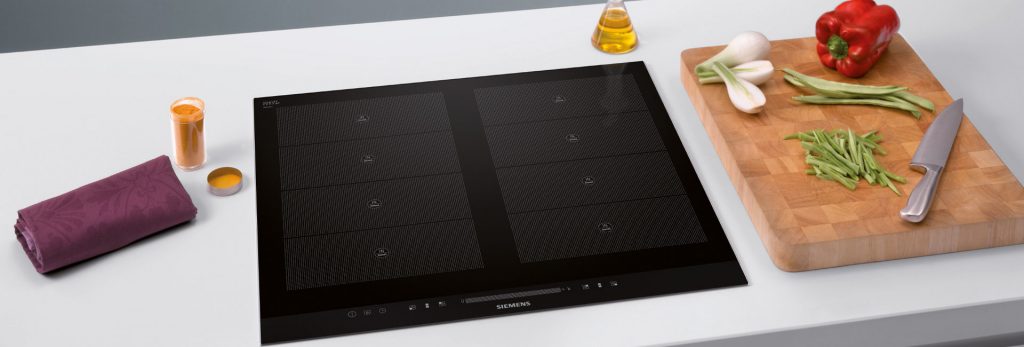
Furthermore, there are accessories which give you even more options for your cooking, such as a Tapenyaki pan or a griddle pan. Here is a video demonstrating the capabilities of these hobs with Siemens Flex Induction hobs:
Summary
Hobs come in all different shapes and sizes, the key is to understand which one is best for your cooking style and needs. Induction cooking is one area where we always start with customers because most customers will find that this suits all of their needs perfectly. If you have a very specific purpose where you need to use gas, then add a domino hob with a single or double ring. Particularly consider flex-induction cooking, it really could take your cooking experience to a whole new level.
Be sure to think about all aspects of hob cooking before your purchase, extraction and controls are usually an afterthought, but they could be essential for creating a great cooking experience.If you need further assistance in choosing the right hob for your kitchen, visit a showroom, call us on 01223 213266 or email info@cambridgekitchens.co.uk.
